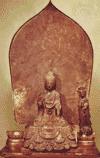- Tori style
-
In Japanese art, a style of sculpture that emerged during the Asuka period (552–645) and lasted into the Nara period (710–784).Derived from the style of the Chinese Northern Wei dynasty (AD 386–534), Tori was named after a sculptor of Chinese descent whose only known piece is a Buddhist triad (623). Works in the Tori style are characterized by slender, elegant bodies, a strong linear interest in drapery, and a tendency toward squatness in the proportion of the faces and also in the relation of the body to the feet.
 Bronze triad of Shaka with attendant figures (left figure lost) in the Tori style, Asuka period, ...By courtesy of the Horyu-ji, Nara, Japan
Bronze triad of Shaka with attendant figures (left figure lost) in the Tori style, Asuka period, ...By courtesy of the Horyu-ji, Nara, Japan* * *
▪ Japanese sculpturein Japanese art, style of sculpture that emerged during the Asuka period (ad 552–645) and lasted into the Nara period (645–794). It was derived from the Chinese Northern Wei style (ad 386–534). It is called Tori (Kuratsukuri Tori) after a sculptor of Chinese descent whose only known piece is a Buddhist triad, which was made in AD 623 as a memorial to Prince Shōtoku. It represents the Buddha Śākyamuni (Shaka) seated on a throne that is flanked on either side by bodhisattvas, with a great mandorla behind.Works in true Tori style are very reminiscent of Northern Wei sculpture found at the site of Lung-men in China. Stylistic characteristics include slender, elegant bodies, a strong linear interest in drapery, and a tendency toward squatness in the proportion of the faces and also in the relationship of the body to the feet.* * *
Universalium. 2010.
